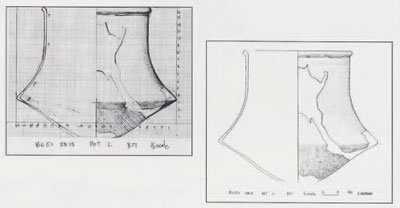
“Illuminating the Past” takes the reader behind the scenes, where sites are prepared for publication.
Pottery vessel from Ban Chiang Burial 71; drawing by Ardeth Anderson
The University of Pennsylvania Museum recently presented a small but very important temporary exhibit entitled “Illuminating the Past: The Art and Artists of the Ban Chiang Project.” The purpose of this exhibit, which was superbly curated by Dr. Joyce White (Research Specialist in the Asian Section) and ably installed by Raymond Rorke, was to show how archaeologists prepare their final reports after an excavation has been completed (in this case at Ban Chiang in Thailand). Although most public attention is understandably fbcused on the fieldwork component of archaeological research, the lesser-known and understood analysis and publication preparation phases are just as significant.
The exhibit featured the work that artists and draftspeople do to convert site plans and profiles into publishable line drawings and to render as understandable pictures the artifacts uncovered during excavation. The latter often take not only great skill but also ingenuity, as in the case, for example, of depicting stone tools and the kinds of chipping ancient peoples employed to manufacture them.
Although the prepublication phase of an archaeological project is decidedly unglamorous, it is essential. Excavation without publication has little value, no matter how important the finding. Moreover, excavation involves the destruction of archaeological contexts that cannot be restored. If the analysis and publication of the excavated materials is not undertaken, then archaeologists leave themselves open to the charge that their work is not much different than looting.
Financial support for archaeological analysis, report preparation, and publication is often much more difficult to obtain than for field research, and the former activities can be relatively expensive. What this means for our Museum is that we just have to try harder to secure such funding if we are to fulfill our obligations to both the scholarly community and to the general public.
Jeremy A. Sabloff
The Charles K. Williams II Director
